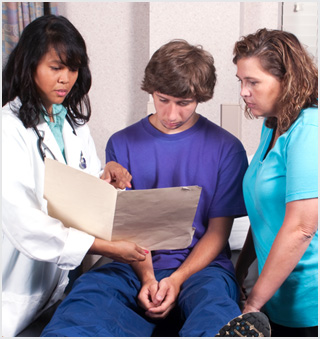Communicating the Importance of HPV Vaccination
A recent study reports that how pediatricians talk to parents can affect whether or not they chose to have their child vaccinated against human papillomavirus (HPV).

For pediatricians and parents of adolescents, across the nation, an important decision about a child’s long-term health could hinge on a few words. The way the pediatrician talks about vaccination against the human papillomavirus (HPV) can have a major impact on that decision.
A study published this fall in Cancer Epidemiology, Biomarkers & Prevention (CEBP), a journal of the American Association for Cancer Research, showed that the words the physician uses may have a strong influence on that decision.
HPV causes most cases of cervical cancer and a large proportion of vaginal, vulvar, anal, and penile cancers. It is also a risk factor for oropharyngeal cancers. The U.S. Centers for Disease Control and Prevention (CDC) recommended that boys and girls age 11 or 12 receive two doses of HPV vaccine at least six months apart, rather than the previously recommended three doses.
But the latest data from 2015 found that only 42 percent of girls and 28 percent of boys ages 13 to 17 had completed the then recommended three-dose HPV vaccine series, according to the CDC.
In February 2016, the nation’s 69 NCI-Designated Cancer Centers released a consensus statement that called the low HPV vaccination rates a “serious public health threat.”
Researchers believe there are many reasons for the low uptake, but one major factor is that physicians don’t always strongly endorse HPV vaccination or recommend it in a timely manner, according to a study published in CEBP in October 2015.
More recently, Teri L. Malo, a postdoctoral research associate at the UNC Lineberger Comprehensive Cancer Center and the Department of Health Behavior, Gillings School of Global Public Health, at the University of North Carolina at Chapel Hill, set out to evaluate whether the specific language used by physicians would influence parents’ decisions, and whether physicians would be more likely to use specific messages.
Malo and colleagues tested 15 messages with 1,504 parents of adolescents ages 11-17 and 776 primary care physicians. Nine of the messages were previously approved by the CDC. Malo and her team developed six additional messages.
The most persuasive, with 65 percent of parents and 69 percent of physicians endorsing it, was: “I strongly believe in the importance of this cancer-preventing vaccine for [child’s name].”
Malo was surprised to discover that even parents who told the researchers that they were considering not having their children vaccinated against HPV said they could be persuaded by some of the messages. For example, 59 percent of parents said they would be persuaded by hearing: “[Child’s name] can get [anal/cervical cancer] as an adult, but you can stop that right now. The HPV vaccine prevents most [anal/cervical cancers].”
Most of the 15 messages tested in the study were effective with at least half the parents. The least effective, which only 9 percent of parents said would persuade them to have their children vaccinated: “Would you wait until [child’s name] is in a car accident before you tell [him/her] to wear a seatbelt?”
Malo said the study results indicate that physicians should talk to parents extensively enough to understand their concerns, and perhaps tailor their messages to address those specific worries.
“It’s important to understand what drives parents’ hesitation so that we can help improve provider communication to decrease hesitancy about HPV vaccine,” she said.
